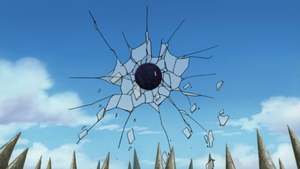m (Changing Collaboration Jutsu to Collaboration Techniques) |
No edit summary |
||
| (19 intermediate revisions by 11 users not shown) | |||
| Line 1: | Line 1: | ||
{{Infobox/Jutsu |
{{Infobox/Jutsu |
||
| + | |ref=<ref name="d4">Fourth Databook, page 318</ref> |
||
|image=Thirty-Six Layer Barrier.png; The barrier hit by B's Tailed Beast Ball… |
|image=Thirty-Six Layer Barrier.png; The barrier hit by B's Tailed Beast Ball… |
||
Thirty-Six Layer Barrier Repairing.png;…repairs itself. |
Thirty-Six Layer Barrier Repairing.png;…repairs itself. |
||
| − | |kanji= |
+ | |kanji=再生結界 |
|unnamed jutsu=No |
|unnamed jutsu=No |
||
| − | |romaji= |
+ | |romaji=Saisei Kekkai |
| − | |literal english= |
+ | |literal english=Self-Repairing Barrier |
| − | | |
+ | |english tv=36-layer Self-Regenerating Barrier |
| − | |jutsu classification=Ninjutsu, |
+ | |jutsu classification=Ninjutsu, Cooperation Ninjutsu, Barrier Ninjutsu, |
|jutsu class type=Supplementary |
|jutsu class type=Supplementary |
||
|jutsu range=Long |
|jutsu range=Long |
||
| − | |teams= |
+ | |teams=Kumo Barrier Team |
|debut manga=536 |
|debut manga=536 |
||
|debut anime=275 |
|debut anime=275 |
||
| Line 16: | Line 17: | ||
|jutsu media=Anime, Manga |
|jutsu media=Anime, Manga |
||
}} |
}} |
||
| − | + | The '''Self-Repairing Barrier''' is a Cooperation Ninjutsu that by linking [[chakra]] from a [[Kumo Barrier Team|team of ninja]], will create a barrier which if damaged, will constantly repair itself with said chakra that emanates from their bodies. The barrier also prevents those outside of it from [[Sensor Type|sensing]] anything inside it through traditional methods. |
|
| − | + | The users can erect as much as 36 barriers, with the highest number being able to stop and contain any individual [[jinchūriki]]. It proved to be strong enough to take a direct [[Tailed Beast Ball]] from [[Killer B]], with only nine of the thirty-six barriers shattering. However, [[Naruto Uzumaki]] transformed into his [[Nine-Tails Chakra Mode]] and forced the Tailed Beast Ball to push the rest of the way through with B following, showing it could not withstand the assault of two jinchūriki. |
|
| + | |||
| + | == Trivia == |
||
| + | * The technique required the combined chakra of six individuals. |
||
| + | |||
| + | == References == |
||
| + | <references/> |
||
| + | |||
| + | [[es:Barrera de las Treinta y Seis Capas Autorreparables]] |
||
| + | [[pl:Saisei Kekkai]] |
||
Latest revision as of 21:06, 28 August 2023
The Self-Repairing Barrier is a Cooperation Ninjutsu that by linking chakra from a team of ninja, will create a barrier which if damaged, will constantly repair itself with said chakra that emanates from their bodies. The barrier also prevents those outside of it from sensing anything inside it through traditional methods.
The users can erect as much as 36 barriers, with the highest number being able to stop and contain any individual jinchūriki. It proved to be strong enough to take a direct Tailed Beast Ball from Killer B, with only nine of the thirty-six barriers shattering. However, Naruto Uzumaki transformed into his Nine-Tails Chakra Mode and forced the Tailed Beast Ball to push the rest of the way through with B following, showing it could not withstand the assault of two jinchūriki.
Trivia
- The technique required the combined chakra of six individuals.
References
- ↑ Fourth Databook, page 318


